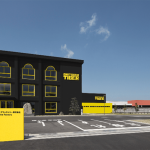Amer Sports reported EBIT (earnings before interest and taxes) slumped 17.0 percent in the first quarter, to €38.2 million from €46.0 million in the year-ago period. The decline reflects income declines in its Outdoor and Ball Sports segments with Outdoor impacted by margin pressures and Ball Sports by lower sales.
Amer Sports brands include Salomon, Wilson, Atomic, Arc’teryx, Mavic, Suunto and Precor.
On a reported basis, EBIT was €31.5 million versus €39.7 million a year ago, a decline of 20.7 percent. Net income reached €19.5 million against €23.2 million, representing a 15.9 percent drop.
Gross margin eroded to 45.3 percent from 47.4 percent a year ago due to less favorable U.S. dollar hedges compared to early 2016.
Revenues increased 4.1 percent to €661.6 million and grew 2 percent in local currencies.
“In the first quarter, we delivered solid growth despite the soft retail landscape especially in the U.S.,” said Heikki Takala, president and CEO.
Among the accomplishments cited for the period was the acceleration of growth in apparel, its own retail network, e-commerce and expansion in China. Said Takala, “We made strong progress in Winter Sports Equipment, and started to rebound in Fitness. And we continued to gain market shares in several categories, most notably performance tennis.”
On the downside, both Sports Instruments and Cycling missed targets during the period although both areas have “exciting initiatives” in the pipeline.
“As the market place and the consumer habits and practices are changing rapidly, we are further accelerating our investment into the omni-channel and digital transformation of the company,” added Takala. “This will give us longer term benefits but weigh in our short-term profitability. We continue to execute at the maximum speed, guided by our strategic glidepath and priorities.”
In its largest segment, Outdoor, revenues grew 5.8 percent in the quarter to €396.2 million and expanded 4 percent in local currencies.
Among Outdoor’s sub-segments, the strongest growth on a currency-neutral basis came in Winter Sports Equipment, up 18 percent to €52.1 million, followed by apparel, ahead 14 percent to €124.4 million. Footwear was up 2 percent to €156.6 million. Declines were seen in Cycling, off 6 percent to €37.7 million; and Sports Instruments, down 26 percent to €25.4 million.
“The wholesale market, especially in the US, continued to be challenging with high trade inventories, impacting particularly Footwear and Cycling,” Amer said. “At the same time, own retail and e-commerce continued to perform well.”
Apparel’s 14 percent gain was driven by Arc’teryx. Winter Sports Equipment’s 18 percent growth was aided by “good snow conditions in many key markets.” Sports Instruments’ decline was due to the timing of product launches.
Amer Sports noted that in March, it acquired Armada, the U.S. ski brand, with annual net sales of approximately U.S.$10 million. Armada will be integrated into Amer Sports Winter Sports Equipment business unit.
On a geographic basis in local currencies, EMEA sales for the Outdoor segment grew 4 percent to €235.5 million; Americas gained 4 percent to €99.3 million, and Asia Pacific improved 3 percent to €61.4 million.
EBIT excluding special items in the Outdoor segment was down 23.6 percent to €28.8 million. The decline reflected a decreased gross margin that impacted EBIT by approximately €9 million and offset the €7 million benefit from the higher sales. The decline also reflected an increase in operating expenses by approximately €11 million.
In the Ball Sports’ segment, sales eased 0.9 percent to €184.9 million and sunk 4 percent in local currencies. Among its sub-segments in local currencies, Individual Ball Sports was down 3 percent to €88.4 million while Team Sports slumped 4 percent to €96.5 million.
By region, sales in local currencies in the Ball Sports segment in the Americas dropped 5 percent to €125.9 million. EMEA was down 3 percent to €37.8 million while Asia Pacific added 5 percent to €21.2 million.
Amer Sports said its Ball Sports segment was hurt by the “challenging US wholesale market and baseball de-stocking ahead of changes in bat regulations in early 2018.”
EBIT excluding special items in the Ball Sports segment was down 13.2 percent to €16.5 million. Decreased sales in local currencies had a negative impact on EBIT of approximately €3 million and declining gross margin of approximately €4 million. Operating expenses decreased by approximately €4 million.
Amer Sports’ Fitness segment delivered the best performance although profitability remains marginal. Sales rose 8.2 percent to €80.5 million and climbed 8 percent in local currencies. EBIT excluding special items improved to €700,000 from €300,000. By region in local currencies, Americas picked up 2 percent to €50.8 million while EMEA added 16 percent to €16.2 million and Asia Pacific tacked on 10 percent to €13.5 million.
The sales gain in the Fitness segment was attributed to new product launches. The improved earnings were due to the sales gain and lower expenses offsetting some gross margin erosion.
For the current year, Amer Sports now expects EBIT excluding special items to be approximately at the level of 2016. Amer Sports didn’t provide a profit projection in its initial forecast. The company said earnings guidance includes “further accelerated investment into the company’s transformation toward omni-channel and digital to win in the fast changing market place.”
In line with the previous guidance, sales for 2017 are expected to increase for the full year with the gains expected to be biased to the second half of the year. Amear concluded, “The company will continue to focus on growing the core business and the five prioritized areas: Apparel and Footwear, US, China, Business to Consumer, as well as digitally connected devices and services.”
Photo courtesy Solomon
















